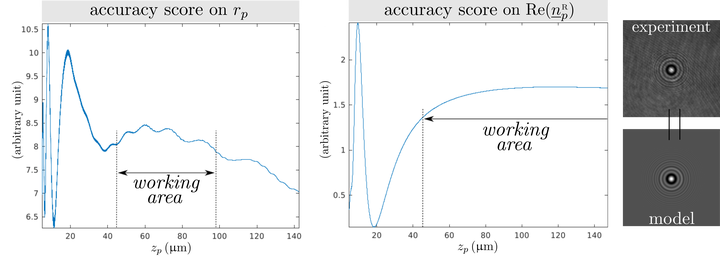Optimizing phase object reconstruction using an in-line digital holographic microscope and a reconstruction based on a Lorenz Mie model
In SPIE Photonics Europe
 Co-design: inferring estimation accuracy with the Cramér-Rao lower bounds.
Co-design: inferring estimation accuracy with the Cramér-Rao lower bounds.
Abstract
Among the various configurations that may be used in digital holography, the original in-line “Gabor” configuration is the simplest setup, with a single beam. It requires sparsity of the sample but it is free from beam separation device and associated drawbacks. This option is particularly suited when cost, compact design or stability are important. This configuration is also easier to adapt on a traditional microscope. Finally, from the metrological point of view, this configuration, combined with parametric inverse reconstructions using Lorenz-Mie Theory, has proven to make possible highly accurate estimation of spherical particles parameters (3D location, radius and refractive index) with sub-micron accuracy. Experimental parameters such as the defocus distance, the choice of the objective, or the coherence of the source have a strong influence on the accuracy of the estimation. They are often studied experimentally on specific setups. We previously demonstrated the benefit of using statistical signal processing tools as the Cramér-Rao Lower Bounds to predict best theoretical accuracy reachable for opaque object. This accuracy depends on the image/hologram formation model, the noise model and the signal to noise ratio in the holograms. In a co-design framework, we propose here to investigate the influence of experimental parameters on the estimation of the radius and refractive index of micrometer-sized transparent spherical objects. In this context, we use Lorenz-Mie Theory to simulate spherical object holograms, to compute Cramér-Rao Lower bounds, and to numerically reconstruct the objects parameters using an inverse problem approach. Then, these theoretical studies are used to challenge our digital holographic microscopy setup and conclude about accuracy, limitations and possible enhancements.